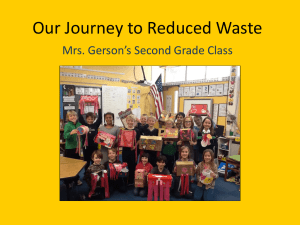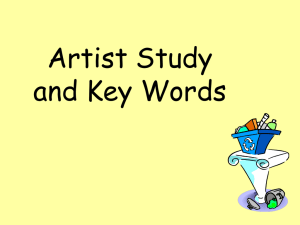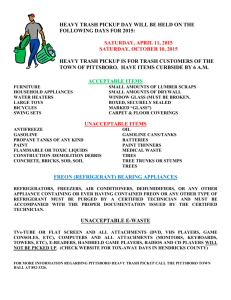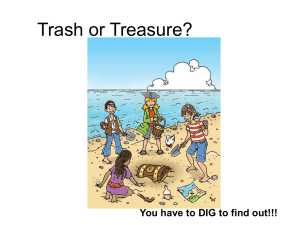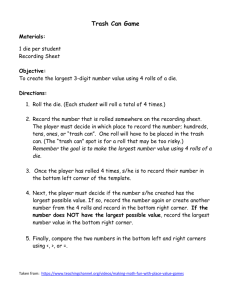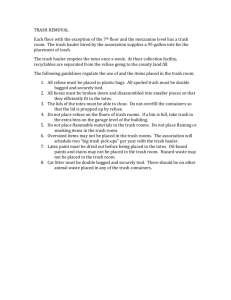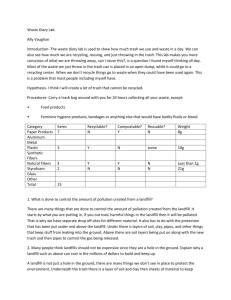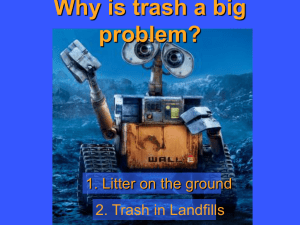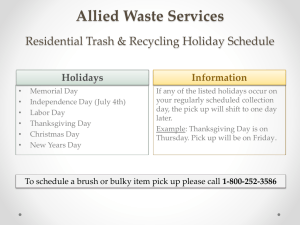Paper Sculpture and Found Art
advertisement
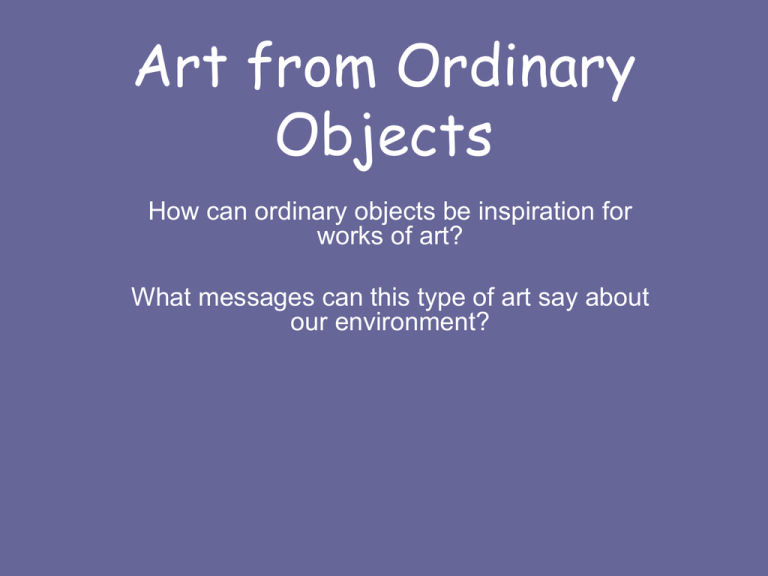
Art from Ordinary Objects How can ordinary objects be inspiration for works of art? What messages can this type of art say about our environment? What do You See? What do you Notice? Coke Totems, environmental artist, John Dahlsen Contemporary environmental art sculpture. Totems made from found plastic objects and stainless steel. Abstract recycled art created from plastics collected from Australian beaches. John Dahlsen, Ocean and Earth Contemporary environmental art wall work, made from found plastic objects, assembled behind perspex (Plexiglass). Semi-abstract/Landscape, recycled art created from plastics collected from Australian beaches. What do you see? What do you Notice? Artist and Sculptor Tara Donovan, Untitled, 2004/2008 Styrofoam cups and glue Untitled, Pin Cube, 2007, Pins Tara Donovan’s sculptures are born of everyday materials such as scotch tape, drinking straws, paper plates, and Styrofoam cups. Donovan takes these materials and “grows” them through accumulation. The results are large-scale abstract floor and wall works suggestive of landscapes, clouds, cellular structures and even mold or fungus. She considers patterning, configuration, and the play of light when determining the structure of her works but the final form evolves from the innate properties and structures of the material itself. In her words, “it is not like I’m trying to recreate nature. It’s more of a mimicking of the way of nature, the way things actually grow.” Untitled, Plastic cups, 2006/ 2008 Untitled, (paper plates) 2003 Paper plates and glue Toothpicks, 2001, toothpicks Transplanted, 2001, Ripped and stacked tarpaper Scotch Tape Sculpture “Trash People” by German Artist HA Schult What do you See??? What do you Notice??? “Cologne People” next to the Cologne cathedral in Germany “One man’s trash is another man’s treasure.” Artist HA Schult takes that saying to the limit: he’s installed 1,000 figures made of debris in front of one of the world’s cultural treasures: the Cologne Cathedral. It took Schult 6 months and 30 assistants to create these strange sculptures. Trash People are lifesize figures the artist began making in 1996 from rubbish collected at the municipal depot in Cologne, the city where Schult lives and works. The figures’ faces are molded from tin cans, their chests constructed from computers, their limbs shaped from crushed plastic. Trash People near the Matterhorn, Switzerland His Trash People have traveled to some of the greatest sites in the world: on China’s Great Wall, near the Egyptian pyramids, on Moscow’s Red Square, at Switzerland’s Matterhorn mountain, at the Grand Place in Brussels and La Grande Arche in Paris. What do you see? Tim Noble and Sue Webster are an incredible artistic duo based in England who have worked on a variety of related projects experimenting with trash and projected shadows. From looking at the rubbish they collect from the streets of London it is virtually impossible to determine a rhyme or reason to the apparent mess. However, once a projector is set up at just the right angle the art pops to life and animated shades are created with crisp and clear outlines delineating the controlled forms hidden with chaos. Recycled Art/Projections by Tim Noble and Sue Webster This trash sculpture was created from recycled carrier bags as part of the Eden Project near Cornwall, UK. Of course, trash ‘art’ isn’t limited to strange sculptures and architectural deconstructions. There is also a great deal of creative recycled urban furniture to keep an eye on not to mention some amazing works of recycled architecture created from bottles, cans, tires and basically any scrap that one can find in bulk. What is the purpose/message of this type of art? HA Shult carefully formed his Trash People Sculptures to remind people of the waste they constantly produce. “We live in the trash time: we produce trash and we become trash. Therefore, my ‘Trash People’ are images of ourselves.” John Dahlsen I see that by making this art, it has been a way of sharing my messages for the need to care for our environment. I feel that even if just a fraction of the viewing audience were to experience a shift in their awareness and consciousness about the environment and art, through being exposed to this artwork then it would be worth it. This stems from the fact that I believe presently humanity is at a critical point in time, with our planet currently existing in a fragile ecological state, with global warming hastening unheard of changes, all amplifying the fact that we need all the help we can get. I see the real need for the massive social transformations that are essential, to adequately deal with such crises as the depletion of fossil fuels and climate change. I hope this work can be a timely reminder to us all of the limited supply of these petroleum based materials, which is a direct result of our current collective global mass consumerism. This is my way of making a difference, and at the same time I’m sharing a positive message about beauty that can be gained from the visual experience of appreciating art, as well as giving examples of how we can recycle and reuse in creative ways. These artworks exemplify my commitment as an artist to express contemporary social and environmental concerns. By presenting this art, to the public it will hopefully have people thinking about the deeper meaning of the work, in particular the environmental issues we currently face. I hope these works will act as a constant reminder to people about awareness. I would like them to find enjoyment the work on many levels and find themselves becoming identified in various ways with each of the artworks they see. I also look forward to the possible discussion that these works may generate as a result. The Eden Project uses exhibits, events, workshops and educational programs to remind people of our dependence on, and connection to, the natural world. Over a million people every year are welcomed to join in our events and learn from our exhibits and we try to ensure all our visitors leave knowing something more about their connections to the world. Enduring Understandings • We are dependent on and connected to the natural world. • Art can be used to send important messages and create awareness of certain concerns. • We can recycle and reuse in creative ways. • Ordinary objects can be inspiration for artwork. We are now going to create our own sculpture from ordinary PAPER CUPS!!! Our focus will be repeated pattern and design!
